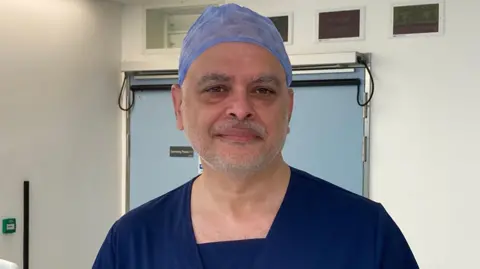New robotic technology brings hope to men with prostate problems
 BBC
BBCDifficulty peeing, a frequent need to go to the toilet and trouble emptying their bladder - those are just some of the problems living with an enlarged prostate can bring men.
Just ask David Fleming, from east Belfast, who has been living with one for a number of years and was one of about 1,000 men on a waiting list for bladder outlet surgery.
If left untreated, an enlarged prostate can lead to more severe symptoms such as acute urinary retention and infections - which is why getting that waiting list down is so important.
Fortunately a new treatment - or more specifically, a new robotic technology - is offering hope that those men can be treated sooner rather than later.
Mr Fleming himself was delighted to be one of the first to undergo aquablation therapy at the Ulster Hospital.
The treatment, the first of its kind across the island of Ireland, is a minimally-invasive procedure that uses a heat-free waterjet to remove excess prostate tissue, which Mr Fleming said will make a big difference to his life.

The 64-year-old's condition, also known as benign prostatic hyperplasia (BPH), worsened early this year and his difficulties peeing led to a catheter being fitted.
But this new treatment will "sort the prostate out so that the flow will be good in the future".
Mr Fleming said his condition was being managed by medication until December but then it "took on a life of its own".
"I would have been waking every hour at night, every hour and a half, so I really wasn't getting much sleep and was really quite tired," he said.
Now, the procedure should solve the issue, ensure the catheter is removed and give him "a good quality of life in relation to what I've had previously".
Mr Fleming hopes, come his 65th birthday in September, he will be "a new man".
How does aquablation therapy work?

While there are several benign prostate treatments available, this treatment particularly helps men experiencing urinary problems due to an enlarged prostate.
Until now, men with a very enlarged prostate had to travel to England for treatment or have more complex or invasive surgery in Northern Ireland.
But this robotic technology eliminates the need for invasive prostate surgery.
It uses image-guided, high-velocity water jets to precisely remove excess prostate tissue.
Real-time ultrasound imaging helps the surgeon map and direct the water jet with accuracy, avoiding damage to nearby nerves and structures responsible for sexual function and continence.
Unlike traditional procedures, no heat is involved, significantly lowering the risk of complications.
The South Eastern Health Trust said this technology reduces the likelihood of side effects such as erectile dysfunction, incontinence and bleeding that may require transfusion.
It also offers a shorter recovery time, shorter hospital stays and lower retreatment rates, improving outcomes for patients.
What could the new treatment do for NI waiting lists?

Ajay Pahuja, consultant urologist at the South Eastern Health Trust, described it as "an exciting new transformative technology" with many benefits for men who have difficulty passing urine.
"It's quite precise, it's safe and quite quick," he said.
"Secondly, we'll be able to probably get patients back to work - an early return to their normal jobs.
"The complication rates are quite low if you're precise."
Mr Pahuja said it also preserves sexual function, which is one of the big things this technology offers.
While TURP is considered the gold standard care for treating benign prostate (BPH), surgeons say aquablation therapy complements the existing technologies they have and will hopefully help tackle the long waiting lists.
Mr Pahuja said the urology waiting list, like other specialities, had a legacy of problems and that those with age-related benign prostate enlargement were waiting "as long as five to seven years" for treatment, with many having to go to England.
He said aquablation therapy could mean more efficient and effective treatment, coupled with the South Eastern Health Trust being declared as a regional BPH centre, should help shorten the waiting lists.

The trust's assistant director of surgery, Katharine Dane, said all men across Northern Ireland will benefit from this new treatment.
She said aquablation therapy was "a real coup" for the trust.
"It just completes the suite of treatment," she said.
Men on a waiting list in other trusts will be transferred to the Ulster Hospital to be offered this service, if that is what is decided is appropriate for their prostate.
